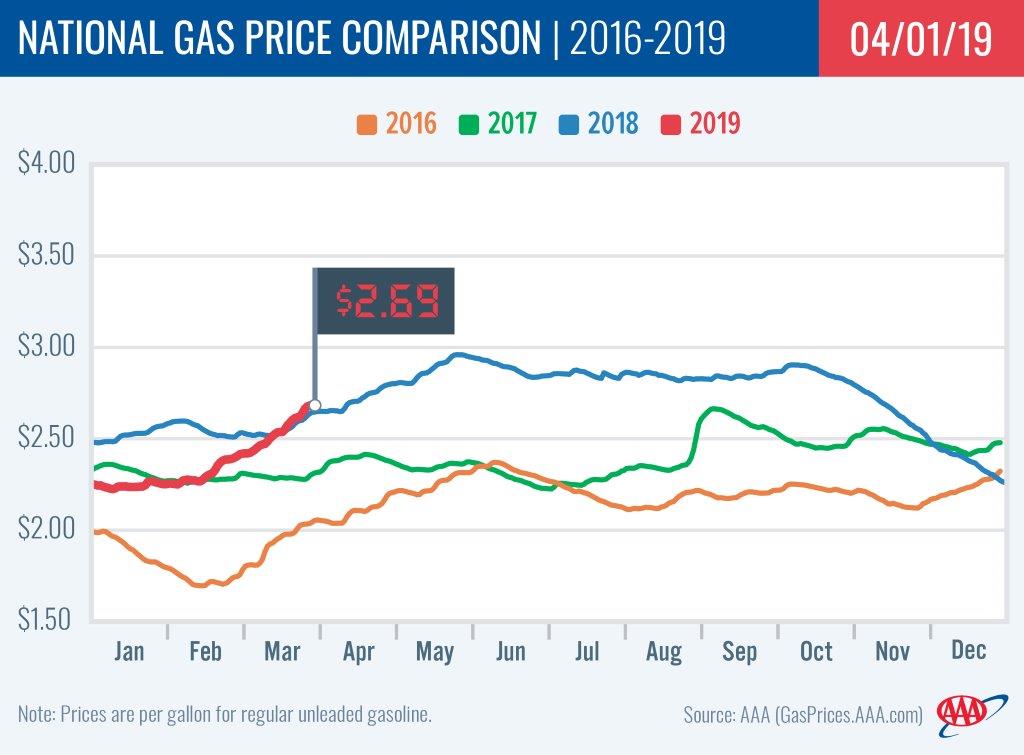Tightening Gasoline Supplies Drive Crude Oil and Pump Prices Higher
PORTLAND, Ore., – Drivers are likely getting sticker shock as they fill up. Pump prices are shooting up across the country due to tightening supplies. For the week, the national average adds a nickel to $2.70 a gallon. The Oregon average jumps seven cents to $3.06. It’s the first time the Oregon average has climbed above $3 since mid-December of last year.
Since the start of the year, the national average has climbed 44 cents and the Oregon average has added 12 cents. “Gasoline stocks have been consistently decreasing since early February, putting upward pressure on pump prices that is likely to continue for the coming weeks,” says Marie Dodds, public affairs director for AAA Oregon/Idaho.
Oregon is one of 47 states and the District of Columbia where prices are higher now than a week ago. California (+11 cents) and Georgia (+9 cents) have the largest jumps. Oregon (+7 cents) has the seventh-largest weekly increase in the country. Delaware, Maryland and Missouri are the three states with weekly decreases; all are one-half cent or less. This week four states, California, Hawaii, Washington and Oregon have averages at or above $3 a gallon, up from three states a week ago.
All 50 states and the District of Columbia have higher prices now than a month ago. The national average is 27 cents more and the Oregon average is 31 cents more than a month ago. This is the ninth-largest monthly increase in the country. Indiana (+37 cents) has the largest monthly jump. Alaska (+12 cents) has the smallest month-over-month increase.
The West Coast continues to have some of the most expensive gas prices in the nation with most of the region’s states landing on the top 10 most expensive list. California is most expensive for the second week in a row, with Hawaii, Washington, Oregon, Nevada, and Alaska rounding out the top six. Oregon is fourth most expensive for the third week in a row. Arizona is the only West Coast state not on the top ten list.
All prices in the region have increased on the week, with California (+11 cents) and Washington (+9 cents) seeing the largest increases.
The U.S. Energy Information Administration’s (EIA) recent weekly report, for the week ending on March 22, showed that West Coast gasoline stocks fell by 200,000 bbl from the previous week and now sit at 31.1 million bbl. Stocks are approximately 1.5 million bbl lower than this time last year, which could cause prices to spike if there is a supply challenge in the region this week.
The nation’s cheapest markets are Utah ($2.41) and Alabama ($2.42). For the seventh week in a row, no states have an average below $2 a gallon.
Oregon is one of 24 states where drivers are paying less than a year ago to fill up. The national average is four cents more and the Oregon average is three cents less than a year ago. Utah (-31 cents) has the greatest year-over-year decrease; Wisconsin (+17 cents) has the largest year-over-year increase.
Oil Market Dynamics
Crude oil prices continue to rise, reaching their highest prices of the year so far. Markets expect further tightening in global crude supplies as a result of OPEC’s 1.2 million b/d production cut and the U.S. imposing sanctions on Iranian and Venezuelan crude exports. Crude prices have shown solid price gains for the first quarter of 2019 and will likely continue their ascent, with the combined effect of the tightening in the global crude oil market overshadowing concerns that the global economy is slowing, which could decrease global crude demand during the second half of 2019. Crude prices rallied despite new EIA data that showed total domestic crude inventories increased by 2.8 million bbl to 442.3 million bbl last week.
In related news, Baker Hughes Inc. reported that the U.S. lost eight oilrigs last week, bringing the total to 816. When compared to last year at this time, there are 19 more rigs this year.
At the close of Friday’s formal trading session on the NYMEX, WTI increased 84 cents to settle at $60.14 – the highest closing price seen this year. At the close of Monday’s formal trading session on the NYMEX, WTI gained $1.45, climbing to another year-to-date high of $61.59. Today crude is trading around $62, compared to $60 a week ago. Crude prices are up about 11 percent in the last month and are about $3 per barrel lower than a year ago.
Drivers can find current gas prices along their route with the free AAA Mobile app for iPhone, iPad and Android. The app can also be used to map a route, find discounts, book a hotel and access AAA roadside assistance. Learn more at AAA.com/mobile.
Diesel
For the week, the national average adds a penny to $3.03 a gallon. Oregon’s average also gains a penny to $3.14. A year ago the national average for diesel was $2.97 and the Oregon average was $3.17.
Find current fuel prices at GasPrices.AAA.com.
AAA news releases, high resolution images, broadcast-quality video, fact sheets and podcasts are available on the AAA NewsRoom at NewsRoom.AAA.com.



